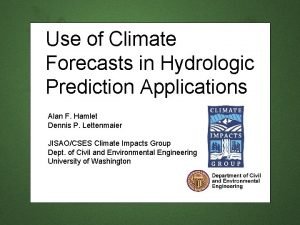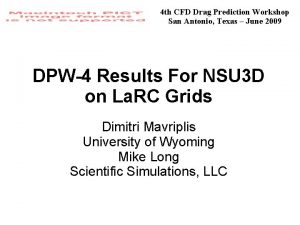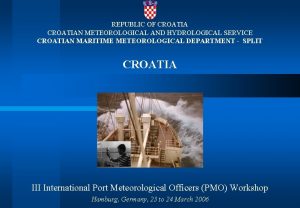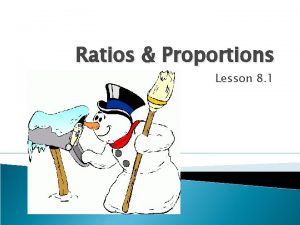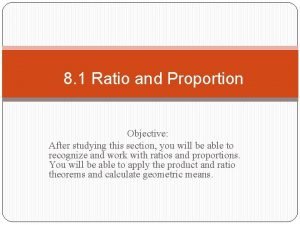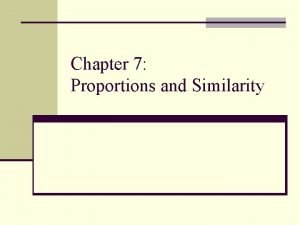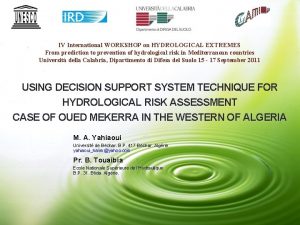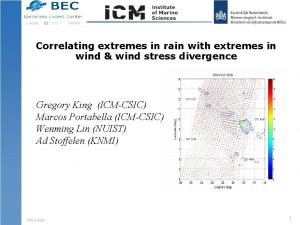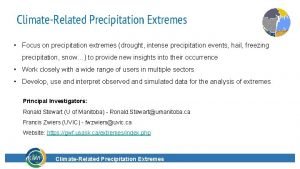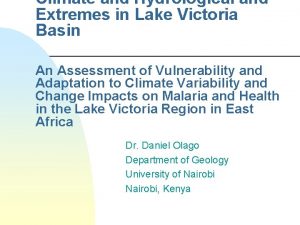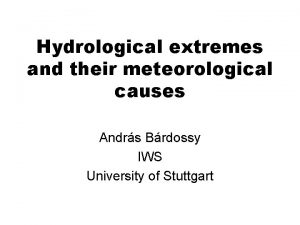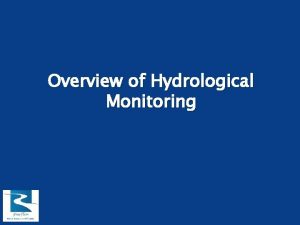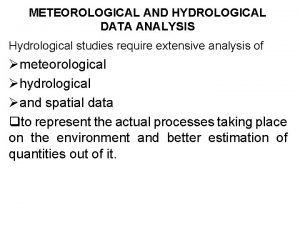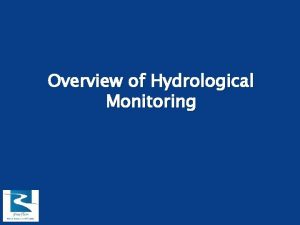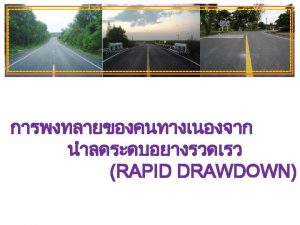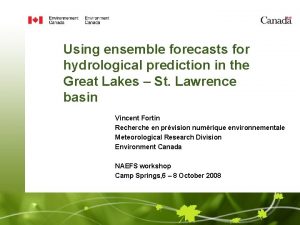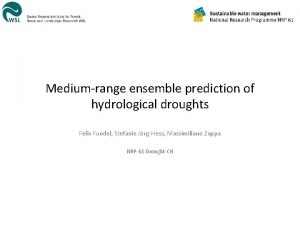IV International WORKSHOP on HYDROLOGICAL EXTREMES From prediction



















- Slides: 19

IV International WORKSHOP on HYDROLOGICAL EXTREMES From prediction to prevention of hydrological risk in Mediterranean countries Università della Calabria, Dipartimento di Difesa del Suolo 15 - 17 September 2011 USING DECISION SUPPORT SYSTEM TECHNIQUE FOR HYDROLOGICAL RISK ASSESSMENT CASE OF OUED MEKERRA IN THE WESTERN OF ALGERIA M. A. Yahiaoui Université de Bechar. B. P. 417 Bechar. Algérie. yahiaoui_halim@yahoo. com Pr. B. Touaibia Ecole Nationale Supérieure de l’Hydraulique B. P. 31. Blida. Algérie.

Introduction 2. Classification of the distribution probability 3. The DSS technique 4. Conclusion 1.

1. Introduction Flood Frequency Analysis is a particular interest for design and management of hydraulic structures. The principal objective of the Flood Frequency analysis is to obtain robust estimates of extremes quantiles and information. Let’s consider the peak flood flow series of oued Mekerra in Relizane departmenent in the west of Algeria. Fitting this sample to Exponential, Weibull, Log normal, Pearson type III and log Pearson type III conducts to the following results:

Size 46 Mean 46. 71 Standard deviation 48. 40 Kurtosis 5. 13 Skewness 1. 62

The question is: For the response to this question, a new technique based on the right tail can be used. Conventional estimates of flood exceedance quantiles are highly dependent on the form of the underlying flood frequency distribution, especially on the form of the right tail which is most difficult to estimate from observed data. The extreme event modelling is the central issue in the extreme value theory, the objective is to provide asymptotic models with which one can the right tail of a distribution.

2. Classification of the distribution probability If X is a random variable with and the mean and the standard deviation. The distribution of X is called heavy tailed if: For the normal distribution Ck = 3 Using this definition, five classes of distributions can be obtained: E = { distribution with non existence of exponential } D = { sub – exponential distributions } C = { regularly varying distribution } B = { Pareto – type tail distribution } A = { – stable (non normal) distribution }

Ouarda et al. (1994) presented a classification of distributions according to asymptotic behaviour of the probability function

By combining this two classifications, distributions commonly used in hydrology can be ordered with respect to their tails.

3. The DSS technique The use of DSS technique as presented by Al-Adlouni, (2010) is presented in the following diagram for class selection

3. 1. The log – log plot tail probability plot is used to study the tail behaviour. This plot is based on the fact that for an exponential tail and for a power law tail with tail index > 1 F (x) is equivalent for large quantiles to: For log – log plot, the tail probability is represented by a straight line for power law or regularly varying distributions (Class C), but not for the other subexponential (Class D) or exponential distribution (Class E).

In practice, the Pareto or the Zipf probability density function is defined as: Where is the only parameter and xmin is the lowest value in the population of X Using the Method of Likelihood To calculate , lets consider the pure power-law distribution, known as the zeta distribution, or discrete Pareto distribution is expressed as: Where ( ) is the Riemann Zeta function is given by the generalized integral: Using the Method of Likelihood:

For the case of oued Mekerra, So it is easy to fitting the peak flow series to Pareto law: From the log-log plot, the series can be fitted adequately to sub-exponential (class D) or exponential (class E) distribution

3. 2. The Mean Excess Function Method (MEF) The MEF is used to discriminate between class D and class E, is based on the function: Which can be written empirically by: Where x(i) is the sample xi for i = 1, 2, …, n but x(1) < x(2) < … < x(n) for and - If the plot is linear and the slope is equal to zero, it suggests an exponential type. - If the plot is linear, the slope is greater than zero and intercept is zero, then it suggests a sub-exponential distribution.

For oued Mekerra the MEF plot is represented in the following figure In this figure, the MEF is practically linear around a mean value with a slope equal to zero, so we suggest an exponential distribution for the fitting.

3. 3. Confirmatory analysis The confirmatory of the class of distribution can be done with the use the : The Generalized Hill Ratio Plot The Jackson Statistic Plot >>> For the generalized Hill ratio plot: Where, The generalized Hill method is an estimation method too of the parameter of the Pareto distribution. The slope of the straight line is close to 1. 26 so the exponential distribution will be used.

>>> For the Jackson statistic plot: For, If the curve converge to 2, the studied distribution belongs to the class C. Although, if the curve presents some irregularities for the distribution tail, the studied distribution belongs to the class E or exponential distribution. For oued Mekerra, the exponential probability distribution is the adapted law.

The exponential probability distribution is given for x m by : the fitting of peak flow series to the exponential distribution with the method of moments is adequate and conducts to: T (year) QIXAT (m 3/s) 2 5 10 20 50 100 500 1000 32 76 110 143 188 221 299 333 Confidence limits (95%) 18 45 61 77 98 113 150 165 46 108 159 210 278 329 449 500 &

3. Conclusion The Decision Support System technique, is very important in mater of the determining the adequacy probability distribution function in the study of the extremes in hydrology. The classes of distributions that are commonly used in hydrology, in an ordered form with respect to their tails. The illustration of some graphical technique in the DSS in order to discriminate between these classes, especially between D and E. In DSS technique, four methods were considered: the log-log plot, the empirical mean excess function, the Hill ratio plot and the adapted Jackson statistic, all these methods led to the same conclusion when the sample are generated from exponential distribution like in the case of oued Mekerra annual peak flow.

Thank you for your attention… IV International WORKSHOP on HYDROLOGICAL EXTREMES From prediction to prevention of hydrological risk in Mediterranean countries Università della Calabria, Dipartimento di Difesa del Suolo 15 - 17 September 2011
 Hydrological prediction center
Hydrological prediction center Drag prediction workshop
Drag prediction workshop Croatian meteorological and hydrological service founded
Croatian meteorological and hydrological service founded Hydrological
Hydrological National meteorological and hydrological services
National meteorological and hydrological services Condensation process example
Condensation process example Vietnam meteorological and hydrological administration
Vietnam meteorological and hydrological administration Hydrological cycle diagram
Hydrological cycle diagram Extremes of a proportion
Extremes of a proportion Bicultural couples tend to demonstrate extremes in
Bicultural couples tend to demonstrate extremes in Avoid extremes
Avoid extremes Means-extremes property of proportion
Means-extremes property of proportion What is the upper quartile of the data? 3 5 6 8
What is the upper quartile of the data? 3 5 6 8 Means extremes product theorem
Means extremes product theorem Similarity ratio definition
Similarity ratio definition Means extremes ratio theorem
Means extremes ratio theorem The ability to produce novel and valuable ideas is called
The ability to produce novel and valuable ideas is called Chapter 7 similarity
Chapter 7 similarity Means and extremes
Means and extremes Means and extremes
Means and extremes
